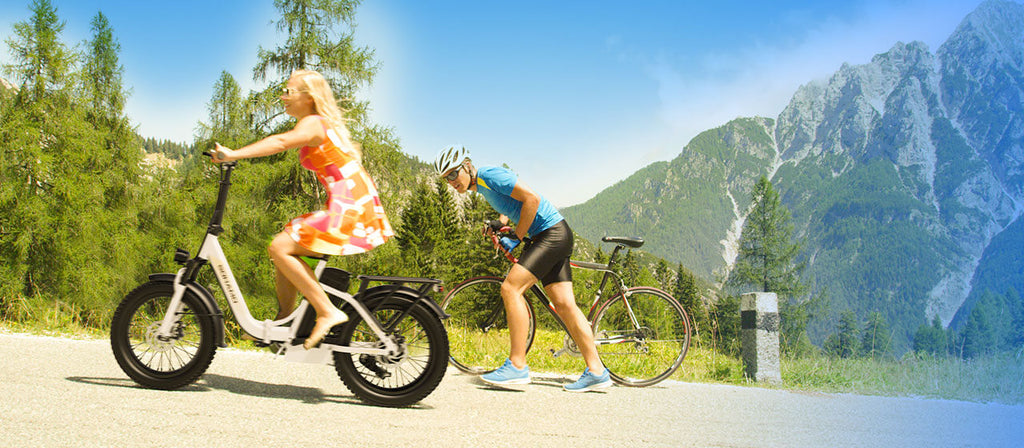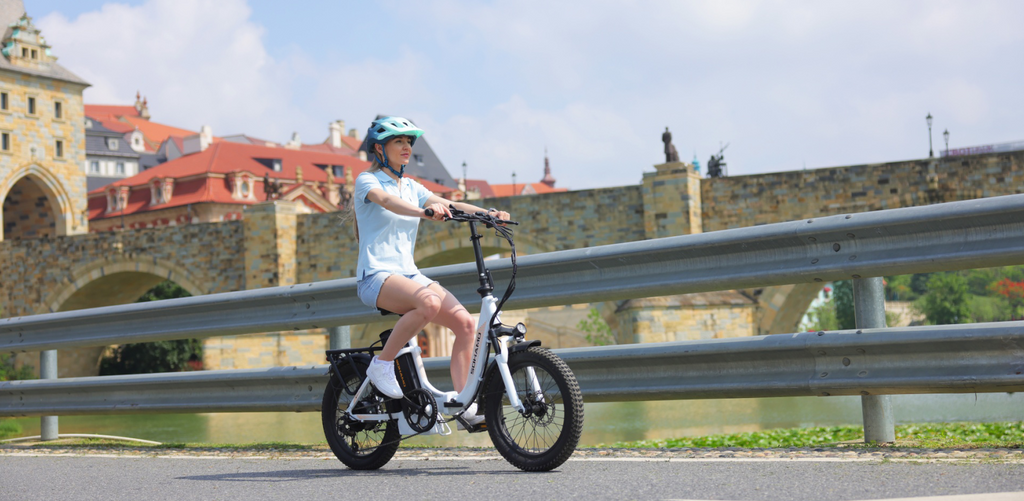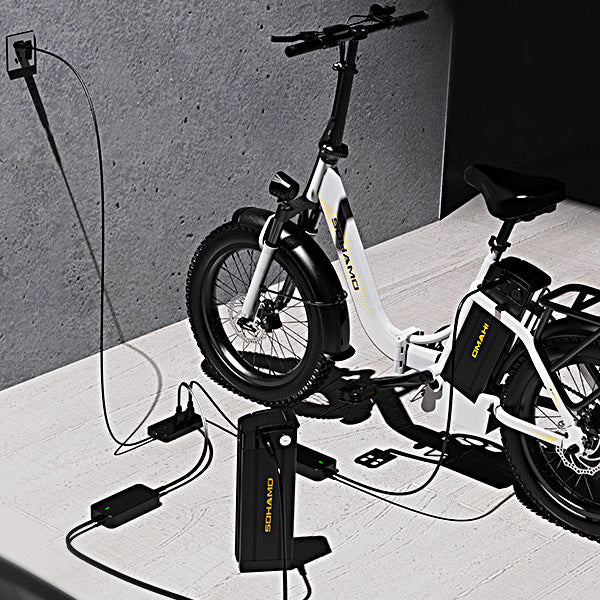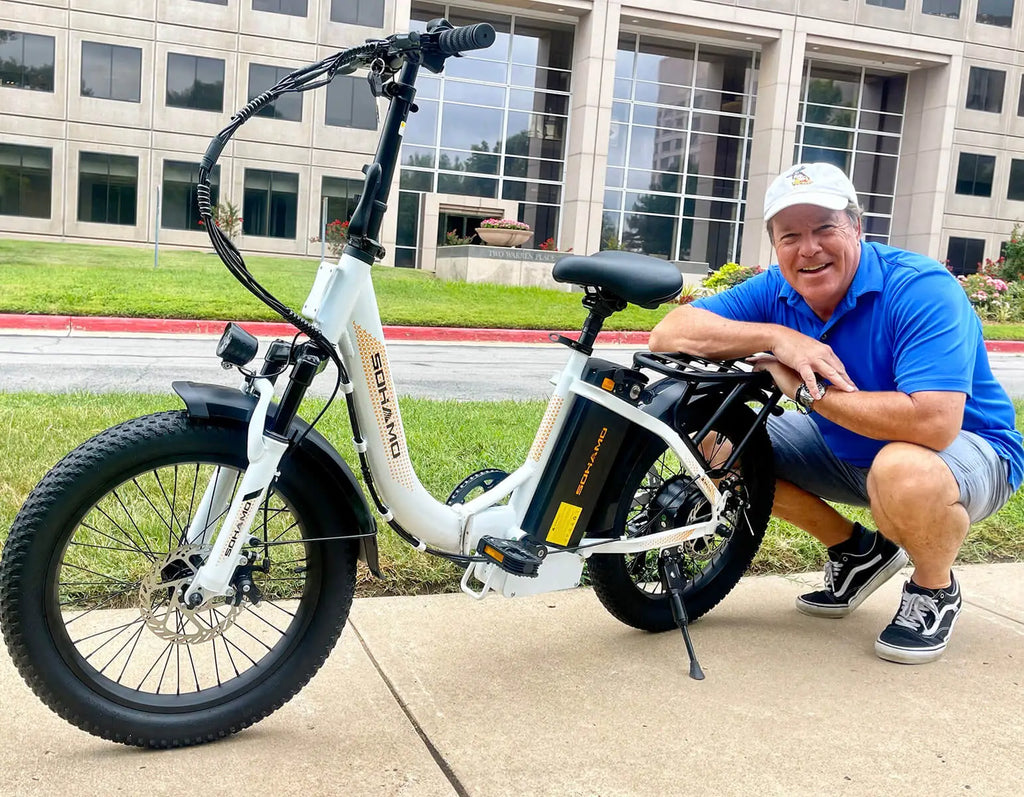
350W vs 500W vs 750W Ebike: Friendly Comparison for Riders

Overview of Electric Bikes (E-Bikes)
Understanding E-Bikes
In recent years, e-bikes have become increasingly popular as a means of convenient, sustainable, and enjoyable transportation. As someone who loves the idea of combining exercise and commuting, I find electric bikes to be an innovative solution for navigating urban landscapes. There are many types of electric bikes available on the market, each with different features and specifications to suit various rider preferences.
An e-bike, or electric bike, is essentially a bicycle with an integrated electric motor that provides assistance when needed. This feature is particularly helpful for climbing steep hills, long rides, or when extra speed is desired. There are quite a few different types of electric bikes, including electric mountain bikes, electric road bikes, electric hybrid bikes, electric cruiser bikes, and electric folding bikes. Each type differs in design, purpose, and usage.
When it comes to power output for e-bikes, you'll often come across motors with varying wattages such as 350W, 500W, or 750W motors. These represent the power and performance capabilities of the electric motor. Generally, a higher wattage motor will provide more power and speed, but it also consumes more battery life. Depending on your specific needs and riding conditions, you may want to choose a different motor power.
As a rider, it's important to understand the basics of e-bike motor power to determine which option is best for you. Consider factors like your riding style, the terrain you will be tackling, and your expectations for speed and performance. By comparing e-bike motor powers, you can find the best fit for your personal riding needs and maximize the benefits of using an electric bike.
Power and Motor Comparison
Understanding The Power
When it comes to e-bikes, one of the primary factors to consider is the power output of the motor. Motor power, measured in watts, plays a crucial role in determining an e-bike's performance, speed, and efficiency. The most common wattage options for e-bike motors are in the range of 350W, 500W, and 750W. In this section, I will do a brief comparison of these power levels to help you understand their key differences.
For an e-bike motor, the higher the wattage, the more powerful it is. A more powerful motor can provide better acceleration, speed, and climbing ability. However, it's important to note that opting for a more powerful e-bike motor will drain the battery more quickly and may be slightly heavier. Therefore, it's crucial to assess your needs before deciding on the best wattage for your e-bike.
Most e-bike motors are either hub or mid-drive motors. A hub motor resides on the wheel's hub, whereas a mid-drive motor connects directly to the bike's chain. Mid-drive motors provide better efficiency and force distribution compared to hub motors, making them suitable for hill-climbing and achieving high speeds.
Now, I'll give you an overview of the differences between 350W, 500W, and 750W motors:
-
350W: A 350W motor is suitable for general commutes and light off-road use. It provides sufficient power for most daily riders and can handle moderate slopes. If you're mostly using your e-bike for city commutes and occasional off-road trips, 350W might be a suitable option.
-
500W: A 500W motor offers more torque, allowing for better hill-climbing abilities and stronger acceleration. It's beneficial for riders who live in hilly areas or encounter steep slopes often. Keep in mind that while 500W motors provide better performance, they also consume more battery power as a result.
-
750W: The 750W motor is the most powerful of the three options, offering even more acceleration, speed, and climbing ability. It's ideal for riders who need extra power, often ride on challenging terrains or desire higher speeds. However, remember that more power means faster battery drain and increased weight.
In conclusion, there's no one-size-fits-all solution when it comes to e-bike wattage. Your choice should be based on your specific needs, such as the terrain you're going to ride on, the desired speed, and your personal preferences.
Speed and Performance
Impact of Wattage on Speed
As an e-bike enthusiast, I've learned that the wattage of an e-bike motor plays an essential role in the bike's speed and performance. From my experience, the higher the wattage, the more power it can deliver, which may lead to faster speeds, better acceleration, and improved climbing ability. However, keep in mind that factors such as gearing, bike design, and pedal input can also influence top speed.
For instance, a 350W e-bike motor might provide a top speed of up to 20 mph (32 km/h) in favorable conditions, which is suitable for city commuting and some off-road situations. When I upgraded to a 500W motor, I noticed a slight increase in speed and better climbing capabilities. On the other hand, a 750W eBike is known for higher torque, acceleration, and uphill performance.
350W VS 500W VS 750W Performance
Based on my research and experience, here's a brief comparison of the performance differences between 350W, 500W, and 750W e-bike motors:
-
350W: This motor is ideal for general commutes and leisure riding. It offers reasonable acceleration and can handle flat terrain and moderate hills. However, it might struggle on steeper inclines or with heavier loads.
-
500W: The 500W motor is a step-up in terms of performance, offering higher acceleration, better climbing ability, and faster top speeds compared to the 350W. It's more suitable for riders who frequently encounter demanding routes or need extra power for carrying loads. Yet, it drains the battery more quickly and is slightly heavier.
-
750W: With greater torque, acceleration, and uphill performance, the 750W motor is perfect for riders who demand maximum power and versatility. The trade-off is its effect on battery life, increased weight, and potentially legal restrictions in some areas.
In conclusion, when choosing the right e-bike, it's important to consider the impact of the motor's wattage on speed and performance. Each motor type offers unique advantages and suits different types of riders. Safe and happy riding!
Climbing and Commuting Capabilities
Climbing Performance
As an avid e-bike enthusiast, I must say there are noticeable differences in climbing capabilities between 350W, 500W, and 750W e-bikes. When it comes to hills and terrain, it's essential to understand how these power variations can impact uphill climbing performance and commuting efficiency.
For a 350W e-bike, it can deliver around 60Nm of torque which is sufficient for an 80kg rider to tackle a 10% incline in pedal assist mode. However, always remember that you shouldn't expect your e-bike to conquer steep hills without a bit of pedaling effort from your end. The 350W e-bike is a decent choice for those who mostly commute on relatively flat terrain and occasional mildly steep hills.
On the other hand, a 500W e-bike can generate 80Nm, allowing a person who weighs 80kg to climb up to a 15% grade, with power up to 750W. This enhanced climbing ability means you'll have a higher acceleration and speed, making it more suitable for those of you who regularly encounter steeper hills or require greater power for quicker commutes. Keep in mind that the higher performance will also drain the battery more quickly and make the e-bike slightly heavier.
As for the 750W e-bike, its power becomes more evident in uphill climbs, especially when compared to a 500W variant. One test showed a considerable improvement of 10 seconds on a PAS 5 sprint test on hills. Although it might not appear significant, a few seconds at one-third of a mile does make a difference in speed. The 750W e-bike can undoubtedly handle more challenging commutes.
To summarize, when it comes to uphill climbing and commuting on various terrains, the capabilities of e-bikes truly depend on their wattage. With higher wattage, you'll enjoy better climbing ability and faster commuting speeds. The choice ultimately depends on your personal preferences, the type of terrain you traverse, and how much climbing you plan to do during your everyday rides.
Pros and Cons
Advantages
As someone who loves exploring different types of electric bikes, I've discovered that there are advantages to using 350W, 500W, and 750W motors. Some of the key points I've found to be beneficial for each motor size are:
-
350W: This motor size is usually suitable for general commutes and lighter riders. It provides 60Nm of torque and enough power to tackle 10% uphill climbs for an 80kg rider in pedal assist mode. As a daily rider, I appreciate the energy efficiency it offers, as it consumes less power.
-
500W: With 80Nm of torque, this motor has more power to climb 15% grade hills for an 80kg rider, and its power can peak up to 750W, which is suitable for riders with more demanding needs. On hilly terrain, I find this motor provides a better overall experience.
-
750W: Preferred by performance-oriented riders, 750W is often found on electric mountain bikes and SUV ebikes for off-roading and long leisure rides. When I want to take my bike for more adventurous and challenging rides, this motor size always delivers a thrilling experience.
Disadvantages
While these different sizes of motors have their advantages, I also understand they come with some drawbacks:
-
350W: For heavier riders or those with frequent uphill rides, this motor size may struggle in providing sufficient power to assist the rider efficiently.
-
500W: Although it offers more power than a 350W motor, it may still not be optimal for very steep or long climbs. Additionally, the increased power comes with higher energy consumption, which can shorten the battery life between charges.
-
750W: The primary disadvantage of choosing a 750W motor is the significant increase in power consumption, resulting in shorter battery life. It might also be excessive for everyday use if not used for its intended purpose, such as off-road trails and challenging terrains.
In summary, it's essential to consider your individual riding needs, style, and preferences when choosing between 350W, 500W, and 750W electric bike motors. Each has its strengths and weaknesses, and finding the right balance will ensure a fantastic riding experience.
Purchase Considerations
Price Analysis
When choosing between a 350W, 500W, or 750W e-bike, one of the primary factors to consider is the price. Generally speaking, as the power of the motor increases, so does the cost of the e-bike. In my experience, a 350W e-bike might be the most budget-friendly option, with prices typically ranging between $1,000 and $2,000. 500W e-bikes often fall within the $1,500 to $3,000 price range, while 750W e-bikes can be found anywhere from $2,000 to $4,000 or even higher. Of course, factors such as brand, build quality, and extra features can also affect the price.
Here's a rough price breakdown for easy reference:
- 350W e-bike: $1,000 - $2,000
- 500W e-bike: $1,500 - $3,000
- 750W e-bike: $2,000 - $4,000+
It's important to keep in mind that these are just general price ranges, and I recommend researching specific models within your budget to find the e-bike with the best value for your needs.
Choosing the Right E-Bike
A crucial aspect of buying an e-bike is selecting the one that best suits your lifestyle, preferences, and budget. Here are some factors I consider when choosing the right e-bike:
- Intended use: Will you be using the e-bike for daily commuting, leisure rides, or tackling challenging terrain? If you're mainly commuting on city roads, a 350W or 500W motor might be sufficient. For off-road or uphill ventures, a 750W e-bike could offer better performance.
- Battery life: E-bikes with higher wattage might consume more battery, so compare battery capacities and estimated ranges before making a decision. Remember, your riding style and terrain can impact battery life, too.
- Legal considerations: Some regions may have restrictions on e-bike motor power or speed limits. Ensure the e-bike you choose complies with local regulations.
- Weight and portability: Higher-wattage e-bikes may be heavier or bulkier, so if you need to carry your e-bike up stairs or for storage, consider a lighter option.
Ultimately, the e-bike you choose should be based on personal preferences, intended use, and budget constraints. Considering all these factors can help you make an informed decision and ensure that you'll be happy with your e-bike for years to come.
Frequently Asked Questions
What is the performance difference between 350W, 500W, and 750W e-bikes?
I notice that the performance difference between a 350W, 500W, and 750W e-bike mainly lies in their power, torque, and speed capabilities. A 350W motor provides 60Nm and 500W peak power while a 500W motor offers 80Nm of torque and can reach up to 750W peak power. The 750W e-bike, on the other hand, offers more speed and power for a thrilling ride.
How does hill climbing ability compare for 350W, 500W, and 750W e-bikes?
When it comes to hill climbing, I find that a 350W e-bike can typically handle a 10% uphill climb while a 500W e-bike can manage steeper hills up to 15% grade. And if you opt for a 750W e-bike, you'll likely experience even better hill climbing abilities.
Do 350W, 500W, and 750W e-bikes have differing range capabilities?
Yes, the range capabilities of e-bikes tend to differ based on their motor wattage and battery capacities. Generally, e-bikes with higher wattages consume more power, potentially affecting their range. However, specific range capabilities depend on factors like battery size, rider weight, and terrain.
How do speed capabilities vary between 350W, 500W, and 750W e-bikes?
I observe that e-bikes with higher wattage motors usually have faster top speeds. While a 350W motor is generally suitable for casual riding and commuting, a 500W motor offers higher speeds for more versatile riding. A 750W e-bike, on the other hand, can deliver even higher speeds and power for adrenaline-pumping rides.
Are there significant differences in battery consumption for 350W, 500W, and 750W e-bikes?
Yes, there are differences in battery consumption among e-bikes with different motor wattages. When I think about battery consumption, I consider that a higher-wattage motor will generally consume more power compared to a lower-wattage one. This means that a 750W e-bike may require more battery capacity or charge relatively faster than 350W and 500W e-bikes to maintain similar ride durations.
What are the pros and cons of choosing a 350W, 500W, or 750W e-bike motor?
For me, a 350W e-bike is suitable for general commuting and provides adequate power for most casual riders. It also tends to be more energy-efficient than higher-wattage e-bikes. A 500W e-bike offers more speed and power, making it a versatile choice for those who want to do more than just commute. However, battery consumption might be a concern for some riders.
As for 750W e-bikes, they deliver exhilarating performance, optimum hill climbing ability, and greater speed capabilities. On the downside, these e-bikes usually consume more battery power and might not be the best choice for people who prioritize energy efficiency and longer battery life.
comments ( 3 )
Vibracion del motor
Sistemas de equilibrado: esencial para el rendimiento fluido y productivo de las dispositivos.
En el entorno de la tecnología avanzada, donde la efectividad y la fiabilidad del sistema son de gran importancia, los sistemas de equilibrado desempeñan un papel esencial. Estos sistemas específicos están creados para ajustar y regular componentes móviles, ya sea en herramientas industrial, medios de transporte de movilidad o incluso en electrodomésticos hogareños.
Para los profesionales en conservación de dispositivos y los técnicos, operar con dispositivos de calibración es esencial para garantizar el desempeño suave y seguro de cualquier mecanismo rotativo. Gracias a estas herramientas avanzadas innovadoras, es posible disminuir considerablemente las movimientos, el zumbido y la presión sobre los sujeciones, extendiendo la longevidad de partes valiosos.
También importante es el rol que cumplen los aparatos de calibración en la atención al usuario. El ayuda especializado y el reparación regular utilizando estos dispositivos permiten brindar prestaciones de excelente calidad, mejorando la contento de los usuarios.
Para los titulares de emprendimientos, la inversión en estaciones de equilibrado y sensores puede ser importante para optimizar la productividad y rendimiento de sus sistemas. Esto es particularmente trascendental para los inversores que manejan modestas y medianas emprendimientos, donde cada aspecto vale.
Además, los dispositivos de ajuste tienen una vasta aplicación en el sector de la prevención y el supervisión de nivel. Facilitan identificar probables fallos, evitando reparaciones onerosas y daños a los equipos. Más aún, los resultados recopilados de estos sistemas pueden aplicarse para perfeccionar procesos y incrementar la presencia en motores de investigación.
Las sectores de implementación de los dispositivos de equilibrado comprenden numerosas ramas, desde la manufactura de vehículos de dos ruedas hasta el seguimiento de la naturaleza. No interesa si se trata de extensas elaboraciones manufactureras o reducidos locales de uso personal, los dispositivos de ajuste son necesarios para asegurar un rendimiento efectivo y sin paradas.
If you have a 350 watt e-bike. Can you use a 1,000 watt battery in order to have longer rides without recharging?




















stromectol images order stromectol for scabies online stromectol 3 mg tablets price
https://gdoorx.com/ – stromectol for dogs